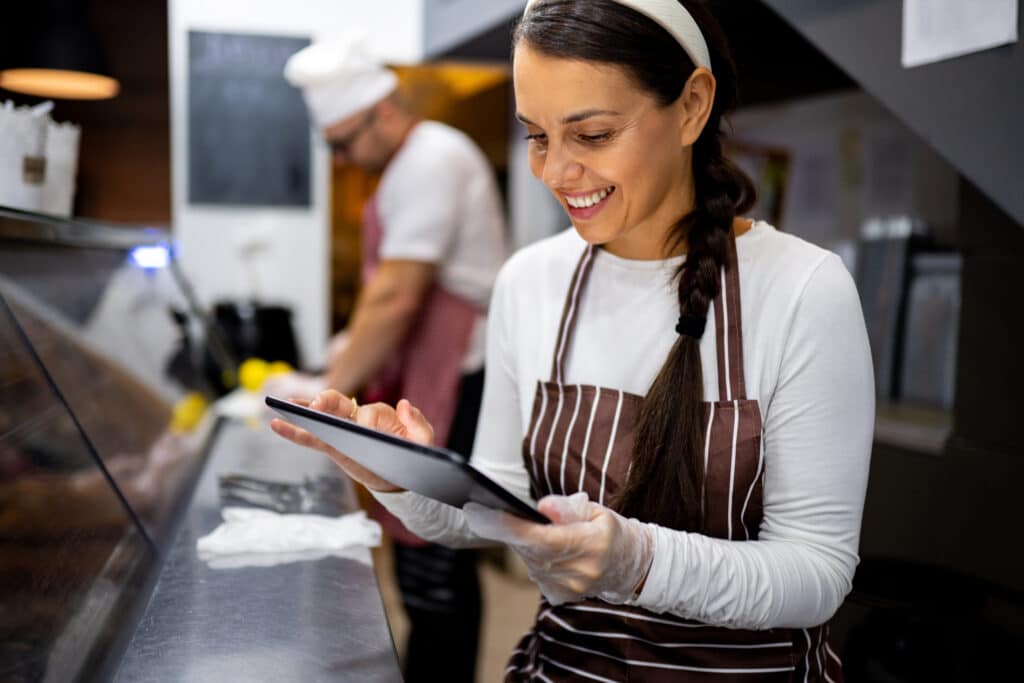When most restaurant owners think about how to manage restaurant inventory, they think of food cost control. For restaurant owners, inventory control is closely related to accounting and food cost management. When tightly integrated with both the accounting system and POS system, inventory tracking is a more useful, accurate tool that can be used to lower cost of goods sold (CoGS), minimize food waste, and better allocate ingredients.
The nuts and bolts of restaurant inventory management
Restaurant inventory management is the process of tracking the ingredients coming in and out of your restaurant. Inventory control traces the amount of product ordered, everything that comes out of the kitchen and bar, and what is left over as sitting inventory afterward. Inventory tracking also includes product transfers between stores.
Restaurant inventory management can be time consuming and challenging to do well. Although some components of restaurant inventory can be automaticallycalculated through your inventory tracking platform, some must be done by hand daily, weekly, or monthly. For instance, your point-of-sale (POS) system may be able to automatically track theoretical inventory based on sales (in product or dollars). But that automated number doesn’t account for potential inventory item loss through incorrect preparation, kitchen waste, ordering errors, or spoilage.
To gain an accurate inventory management picture, you must compare the theoretical inventory, based on POS data, and a count of your actual sitting inventory on the shelf. Calculating the variance between their theoretical and actual inventory in real time with an advanced inventory management solution shows what inventory you are selling, and what inventory is unaccounted for in sales and going to waste somewhere along the way.
Inventory tracking is not only critical for the day-to-day financial health of a restaurant, but it also informs long-term business strategy as well. Food costs are one of the biggest budget items in a restaurant. Accurate restaurant inventory management shows the flow of individual inventory items, highlighting the losses to address.
Restaurant inventory management goes beyond counting inventory
Managing inventory is not just counting the items on the shelves, but also understanding how the amount of product relates to your profit margin. Tight integration between your restaurant inventory management software, restaurant accounting software and POS system is critical for key restaurant tasks that help you control your food costs.
End-to-End Inventory Management
End-to-end inventory management covers everything from counting and transferring to ordering and invoicing. When your restaurant inventory management solution is part of your restaurant accounting platform, you can use one platform to automate invoice uploading, record stock counts, and auto-update item prices. By automatically collecting relevant data in one place, you can speed up tracking from the sheet to the shelf and ensure you are working with real-time pricing data.
Recipe Costing
Mapping your recipes to your POS system menu items helps you understand and control your food costs. Recipe costing breaks down menu items to the details of portion size and individual ingredients, calculated to the penny.
Manually calculating menu item costing is error prone and time consuming. The usage and yield of each food ingredient determines recipe costs, but tracking this by hand on an inventory list can be unreliable. With a restaurant inventory management system integrated with your accounting and POS system, you can automatically track the yield from each food item on your menu by mapping inventory against sales.
Menu Engineering
Menu engineering is the intersection of data about quantities sold and item margin, informed by recipe costing and sales mix polling brought in from your POS system. Menu engineering maximizes profitability by helping you determine the most profitable menu items so that you can subtly encourage customers to buy what you want them to buy.
Menu engineering helps you make informed, data-driven decisions about popularity versus profitability. You can see whether menu items are overpriced or underpriced, based on their food costs, and make decisions about revising portions or recipe ingredients. You can seize new menu opportunities to promote menu items that are high margin but low in sales.
Restaurant inventory management tips and best practices
Below are some tips for optimizing inventory control to make sure you are seizing opportunities to reduce food costs and increase profit margins.
1. Use an inventory management system that integrates with your POS system for recipe costing and menu engineering
Your POS system contains valuable historical data about sales, accounting, and customer behavior that can be used to make better operational decisions in the future. While some inventory management platforms are partly compatible with POS systems, avoid custom workarounds and imports by choosing a restaurant management platform that includes accounting and inventory management, and fully integrates with your POS system.
2. Make it as easy as possible to take inventory
You want your food inventory to be accurate and up to date, so make inventory streamlined for your team. Inventory can be time consuming and slow to do by hand on an inventory sheet, but an efficient platform, with features like reusable templates, can make it easier. Consider choosing an inventory management platform that has a mobile app, allowing your team members to move around the walk-in cooler and dry storage without lugging a clipboard or laptop.
3. Leverage smart forecasting tools
When your restaurant inventory management software is part of an all-in-one accounting and operations solution that’s integrated with your POS system, you can take advantage of smart, data-driven tools. Suggestive ordering is based on sitting inventory, sales, and forecasting, informed by your POS system and budgets. By purchasing food, beverage, and supply orders at the right level, you reduce waste and save on food costs.
4. Analyze reports based on inventory and accounting data
Insights about past and current inventory help you make better choices to improve your operations in the future. By streamlining collection of inventory item and budget data, you save time and ensure accuracy. In particular, tracking theoretical vs. actual food cost variance, using real-time reports, can help you spot trends over periods of time and make improvements to your food cost.
Conclusion
Understanding the relationship between inventory and your POS system allows you to make better-informed decisions about your food costs, ultimately building a healthier profit margin.
If you would like to easily track your inventory and gain insight into your restaurant operations, consider a comprehensive, restaurant-specific accounting and operations solution that includes inventory management software as part of the platform. With Restaurant365 you can save on food costs by making adjustments in the moment, based on up-to-date information. Restaurant365 is a cloud-based restaurant management solution that’s integrated with your POS system, as well as to your food and beverage vendors, payroll provider and bank. For more information, schedule a free demo.



